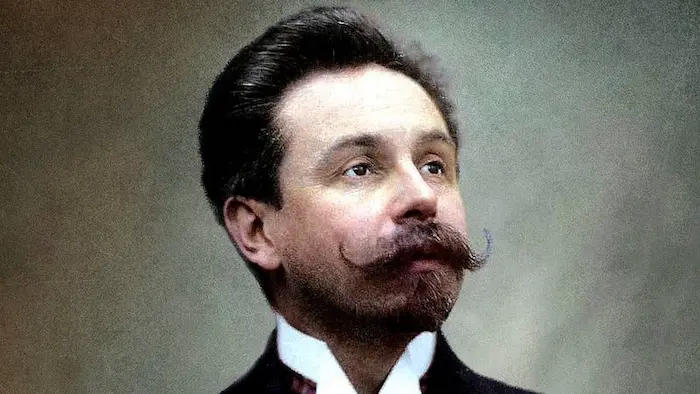Alexander Scriabin, a Russian composer and pianist, is known for his innovative and highly individual style. His Sonata No. 2, also known as the “Sonata-Fantasy,” is a key work in his early period. Composed between 1892 and 1897, this sonata stands out for its lyrical beauty and emotional depth. It reflects the influence of Chopin and Liszt while showcasing Scriabin’s unique voice.
I. Structure and Form
The Sonata No. 2 is in G-sharp minor and consists of two movements:
Andante
Presto
1. First Movement: Andante
a. Lyrical Opening
The first movement, Andante, opens with a gentle, lyrical theme. This melody sets a calm and serene mood. The music flows smoothly, reminiscent of a boat gliding on calm waters. The right hand plays a singing melody, while the left hand provides a flowing accompaniment.
b. Development and Complexity
As the movement progresses, the music becomes more complex. Scriabin introduces new themes and variations. The dynamic range expands, moving from soft, delicate passages to more powerful, intense sections. The interplay between the hands becomes intricate, showcasing Scriabin’s pianistic skill.
c. Climax and Resolution
The movement reaches a climax with a passionate outburst. This section is marked by dramatic chords and rapid arpeggios. The intensity gradually subsides, leading to a return of the opening theme. The movement ends with a peaceful resolution, echoing the serene beginning.
2. Second Movement: Presto
a. Energetic Opening
The second movement, Presto, is a stark contrast to the first. It begins with a burst of energy, marked by rapid octaves and a driving rhythm. The music is fast and exhilarating, creating a sense of urgency and excitement.
b. Technical Challenges
This movement is technically demanding. It requires precision and agility from the pianist. The rapid passages and intricate fingerwork test the performer’s skill. The left hand often plays rapid, repeating notes, while the right hand executes swift, melodic lines.
c. Middle Section: A Moment of Calm
In the middle of the movement, there is a brief moment of calm. The tempo slows down, and the music becomes more lyrical. This section provides a contrast to the surrounding intensity. It allows both the performer and the listener to catch their breath.
d. Finale: A Powerful Conclusion
The movement resumes its fast pace, building towards a powerful conclusion. The music becomes more intense, with thundering chords and rapid scales. The sonata ends with a dramatic flourish, leaving a lasting impression on the listener.
II. Musical Style and Influence
1. Romantic Roots
Scriabin’s Sonata No. 2 is deeply rooted in the Romantic tradition. The lyrical melodies, rich harmonies, and emotional expression are characteristic of this period. Scriabin’s admiration for Chopin is evident in the flowing lines and expressive phrasing.
2. Innovative Harmonies
While the sonata reflects Romantic influences, it also showcases Scriabin’s innovative use of harmony. He employs chromaticism and unconventional chord progressions. These elements add a unique color to the music, setting it apart from his contemporaries.
3. Pianistic Virtuosity
Scriabin was a virtuoso pianist, and this sonata highlights his technical prowess. The demanding passages, rapid arpeggios, and intricate fingerwork are a testament to his skill. The sonata requires both technical mastery and expressive depth from the performer.
III. Performance and Interpretation
1. Notable Performances
Over the years, many renowned pianists have interpreted Scriabin’s Sonata No. 2. Vladimir Horowitz, Sviatoslav Richter, and Evgeny Kissin are among the notable performers. Each brings their unique interpretation to the piece, adding to its rich performance history.
2. Challenges for Pianists
Performing this sonata presents several challenges. The first movement requires a delicate touch and lyrical expression. The second movement demands precision and agility. Balancing the contrasting moods and technical demands is key to a successful performance.
3. Interpretative Choices
Pianists have the freedom to make interpretative choices. Some may emphasize the lyrical qualities of the first movement, while others highlight the dramatic contrasts. The tempo, dynamics, and phrasing can vary, allowing for personal expression.
IV. Legacy and Impact
1. A Milestone in Scriabin’s Oeuvre
Sonata No. 2 is a milestone in Scriabin’s compositional career. It marks his transition from traditional Romanticism to his unique, innovative style. This sonata is a precursor to his later, more experimental works.
2. Influence on Modern Music
Scriabin’s innovative approach to harmony and form influenced many later composers. His exploration of new tonalities and structures paved the way for modern music. Composers like Sergei Prokofiev and Igor Stravinsky drew inspiration from his work.
3. Enduring Popularity
Despite its challenges, Sonata No. 2 remains a popular piece in the piano repertoire. Its lyrical beauty and dramatic contrasts continue to captivate audiences. Pianists enjoy the opportunity to explore its technical and expressive depths.
See Also: A Deep Dive into the Era of Classic Music: All You Want to Know
V. Conclusion
Scriabin’s Sonata No. 2 is a masterpiece of Romantic expression and pianistic virtuosity. Its lyrical melodies, innovative harmonies, and dramatic contrasts make it a compelling work. This sonata stands as a testament to Scriabin’s unique voice and enduring influence in the world of classical music.

